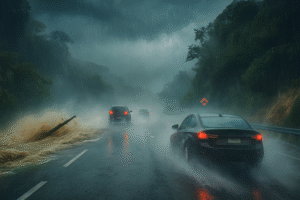Green Energy in Costa Rica (the Great, the Good and the ‘Swept Under the Rug’)

A WORLD LEADER
Costa Rica is amongst the world-leaders when it comes to the use of renewable energy and the race to net-zero. But as we celebrate the sustainability efforts of a country which has spectacularly reversed its generational deforestation trends and protected 25% of its land area and 30% of its marine territories, we have to look at both sides of the debate. Green energy carries some serious drawbacks – and that it is all about understanding the pros and cons, finding a fair & useful balance, addressing shortcomings and navigating the process in a way that ensures the best possible outcome – even if the outcome is to go back to the drawing boards or entirely abandon a project.
GREEN ENERGY TRIUMPHS
For a period of time in 2017, Costa Rica’s entire population of 4.9 million people relied entirely on green energy for 75 consecutive days. The country was the first nation to run itself solely on green fuel for such a long time. Our summer was very wet; that meant the hydro reservoirs were filled to the point where increased water release and thus hydro energy output could be sustained for nearly 2 1/2 months – and combined with the wind, solar, and geothermal generation, the nation was net-zero for a long long while (when it comes to energy generation at least).
And aside from such exceptional circumstances, Costa Rica’s energy averages out to being about 98% green – still a super impressive statistic!
SOURCES OF GREEN POWER
Like many South and Central American countries, Costa Rica receives the lion’s share of its energy from hydro-electricity. The reminder is made of wind and geo-thermal power, with a small portion of bio-mass and solar generation. Factors such as seasonal rainfall, annual average wind speeds, and cloud cover can lead to variation in energy generation by type however the typical annual values are as follows:
- HYDRO: 65%
- WIND: 17%
- GEOTHERMAL: 14%
- SOLAR: >1%
- BIOMASS: >1%

We will look at each of the above in detail, providing additional information as well as the benefits and drawbacks. This article is meant to inform and not to criticize green power – as the detriments of fossil or nuclear electricity generation are, arguably, much more impressive! We are rather looking to highlight that, because there are social & environmental costs associated with all types of power generation, the best path forward is for every resident of Costa Rica to reduce their energy & resource use and look at the most efficient ways to cook, travel, keep their homes & food cool, relax & vacation, and think twice when making choices that have the potential to significantly impact their energy and resource use. And a future article will dig deep into how green living can be actioned by everyone.
HYDROELECTRIC POWER – 65%
Hydro power is Costa Rica’s major electricity generation method – 18 hydroelectric power plants churn around the clock to produce 65% of the country’s electricity, all powered by the rain that falls along the central spine of the country. And there is constant chatter about adding additional capacity.
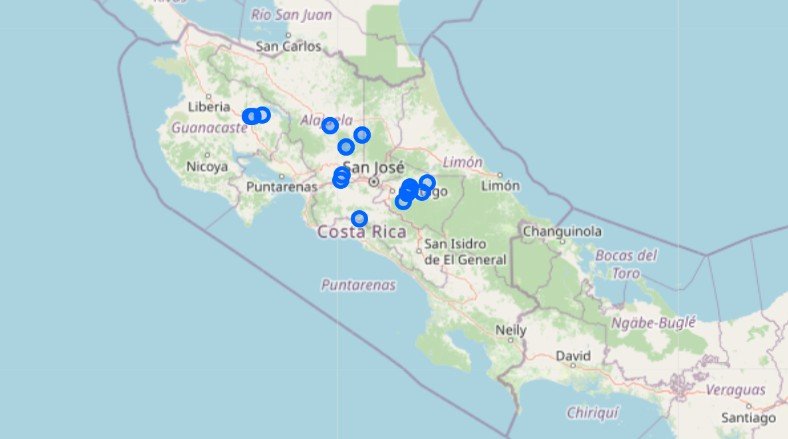
You may have seen a lot of discussion about the proposed Diquis hydroelectric project – this was penned to be the largest hydro dam in Central America. The project was recently cancelled after a spate of financial issues and conflict with local indigenous communities whose territories would be lost and people displaced. Environmental concerns also abounded with lost lands, altered habitats, and serious effects on the mighty Térraba river. So it is not all rainbows and unicorns when it comes to hydro power!
THE GOOD – HYDROELECTRICITY:
Fully renewable. Water, which powers the turbines, is a renewable resource – it falls from the sky and flows into the rivers and streams that feed our hydro lakes, as part of a natural water cycle. This cycle has been operating for billions of years and will operate for billions of years more, we are simply tapping into a tiny portion of the energy that comes from the stored potential of elevated water – elevated by the heat of the sun. After flowing into the powerplant intakes and converting its kinetic energy into the mechanical energy of the spinning turbine, the water is released to continue on its way to the Pacific Ocean or Caribbean Sea.
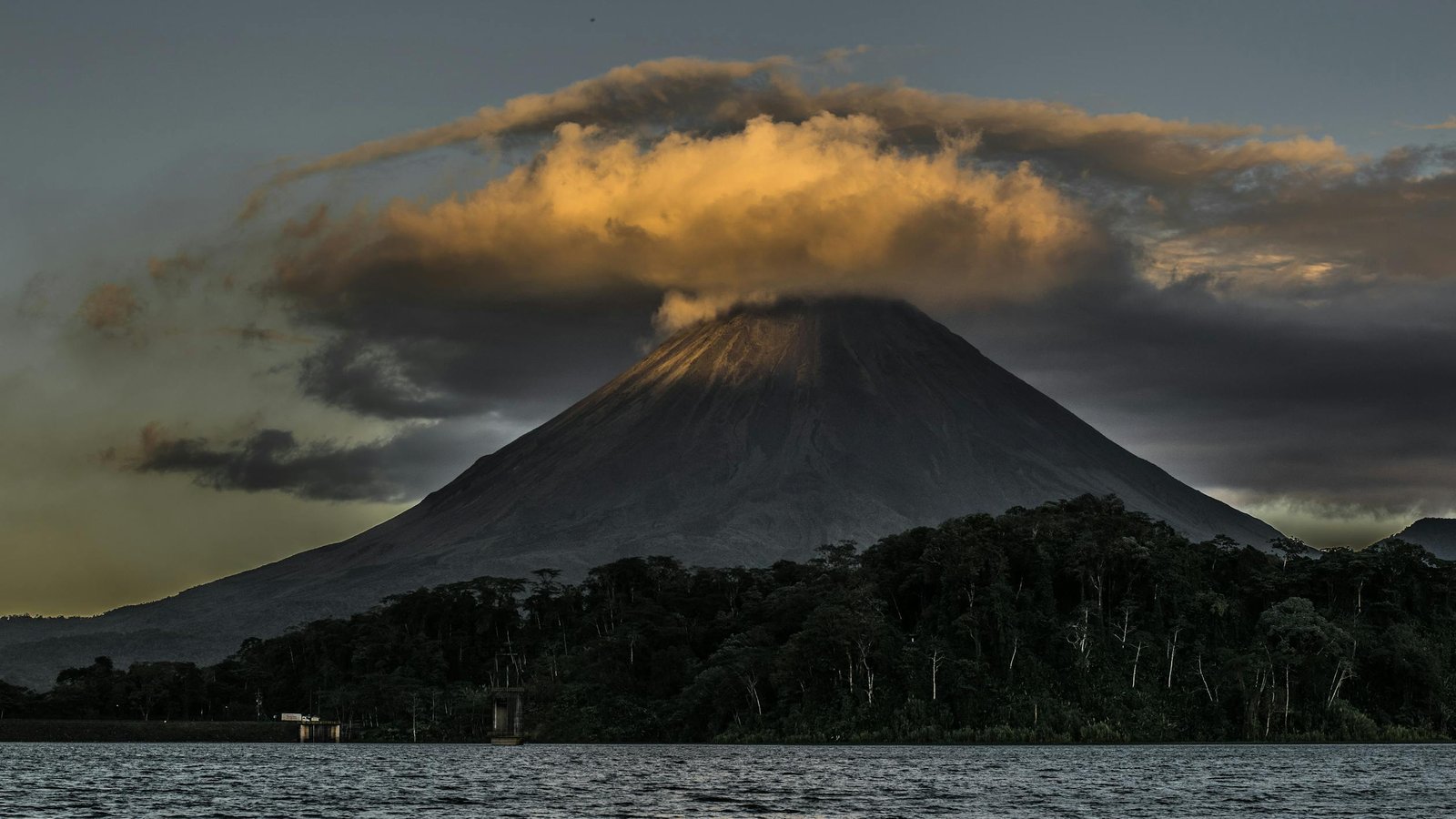
Low production CO2 release. Very little CO2 is emitted during generation, especially as compared to oil or coal plants. The hydro lakes can store vast amounts of potential electricity with the flow being managed to run hot when power is needed and slow down during times of low demand.
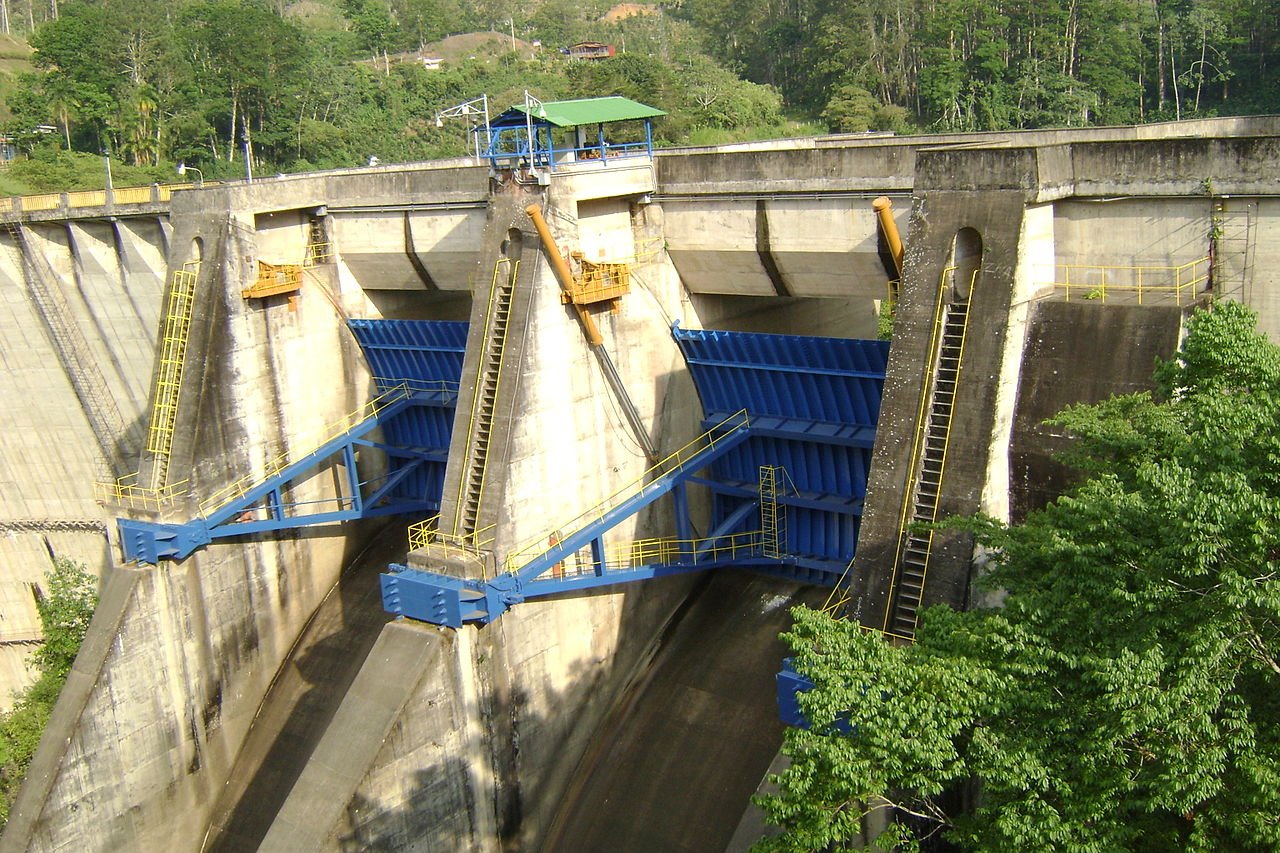
Low operating & lifetime costs. These power plants and lakes last a long time – 50 to 100 years is a typical life span of a hydro plants, with some having been in operation in one form or another for much longer. So, because the initial capital costs are spread over a very wide timeframe and operational costs are fairly low, hydro power is very cheap.
Recreation. The lakes that form behind hydro dams can be used for recreational purposes such as swimming, fishing, and boating – in addition to the creation of valuable aquatic animal habitats. They can also be used to store drinking water, often giving a much more reliable supply.
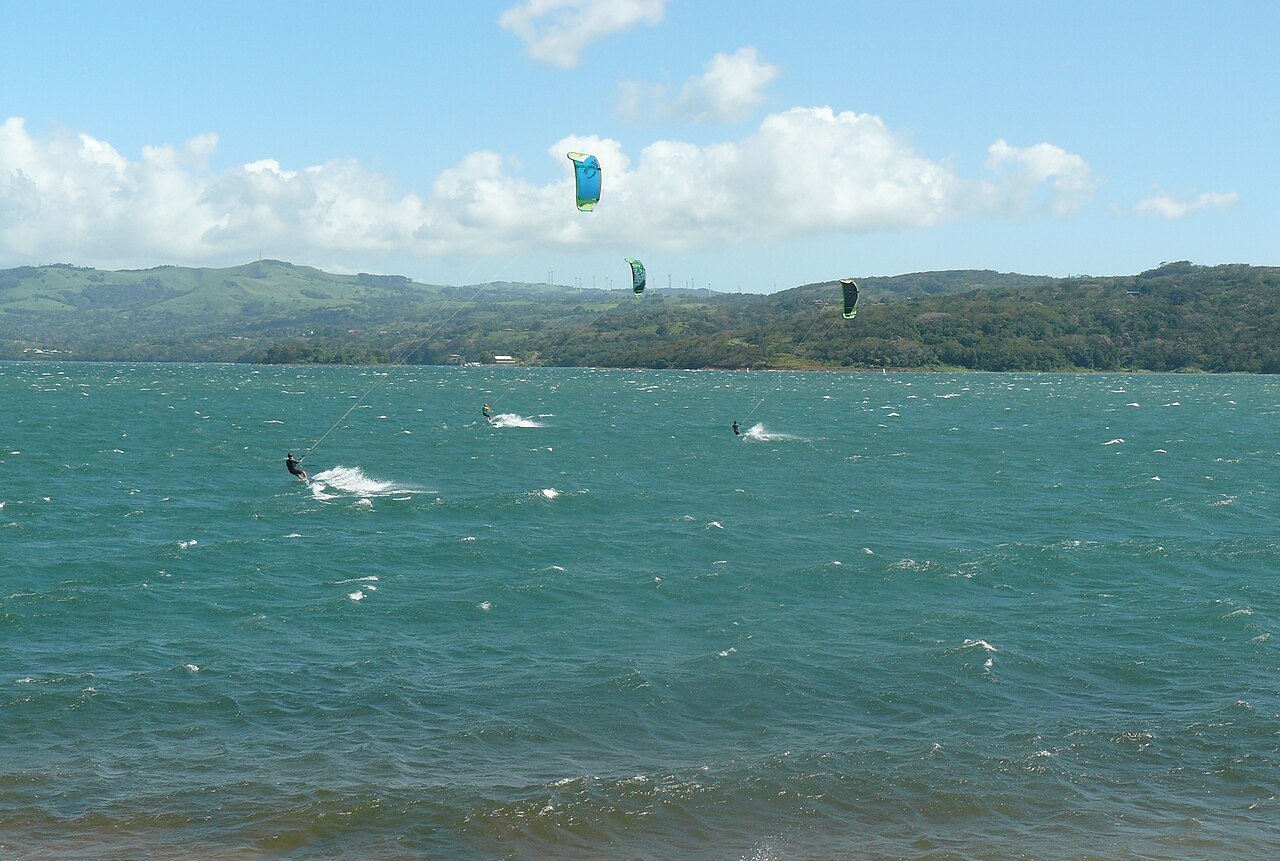
THE UGLY – HYDROELECTRICITY:
Did you know that some hydro plants can be as ‘dirty’ as coal-burning plants? Several factors conspire to tarnish the sometimes undeserved image of hydro power as being 100% green, which is definitely is not.
CO2 emissions during construction. Construction can create significant emissions – the trains, trucks, & ships which move the concrete and raw materials as well as the on-site construction equipment all burn fossil fuels. And concrete releases vast amount of CO2 during manufacturing – in fact cement production is responsible for over 7% of the global CO2 emissions. And as we all know, dams eat up a lot of concrete! Each kilogram of concrete is responsible for 0.5-0.9 kg of CO2 production.
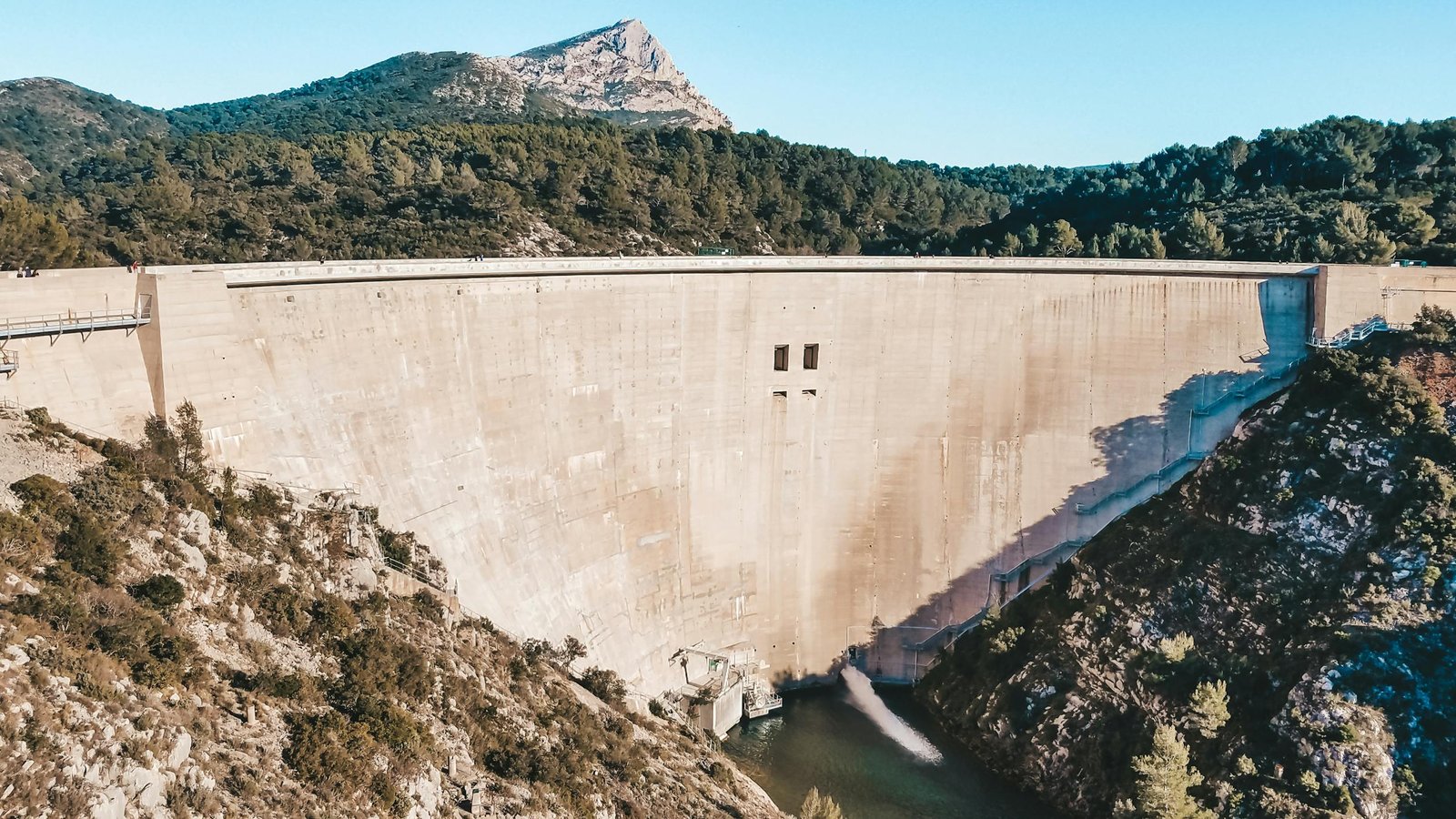
Methane release. One of the biggest drawdowns of hydro power are the increased greenhouse gas emissions via flooding. Vast areas of plants are often flooded by the hydro lakes. These plants then break down and release their stored carbon as Methane, which is a super potent greenhouse gas. And this process can go on for decades. The flooded lands stop being a part of the natural carbon storage cycle.
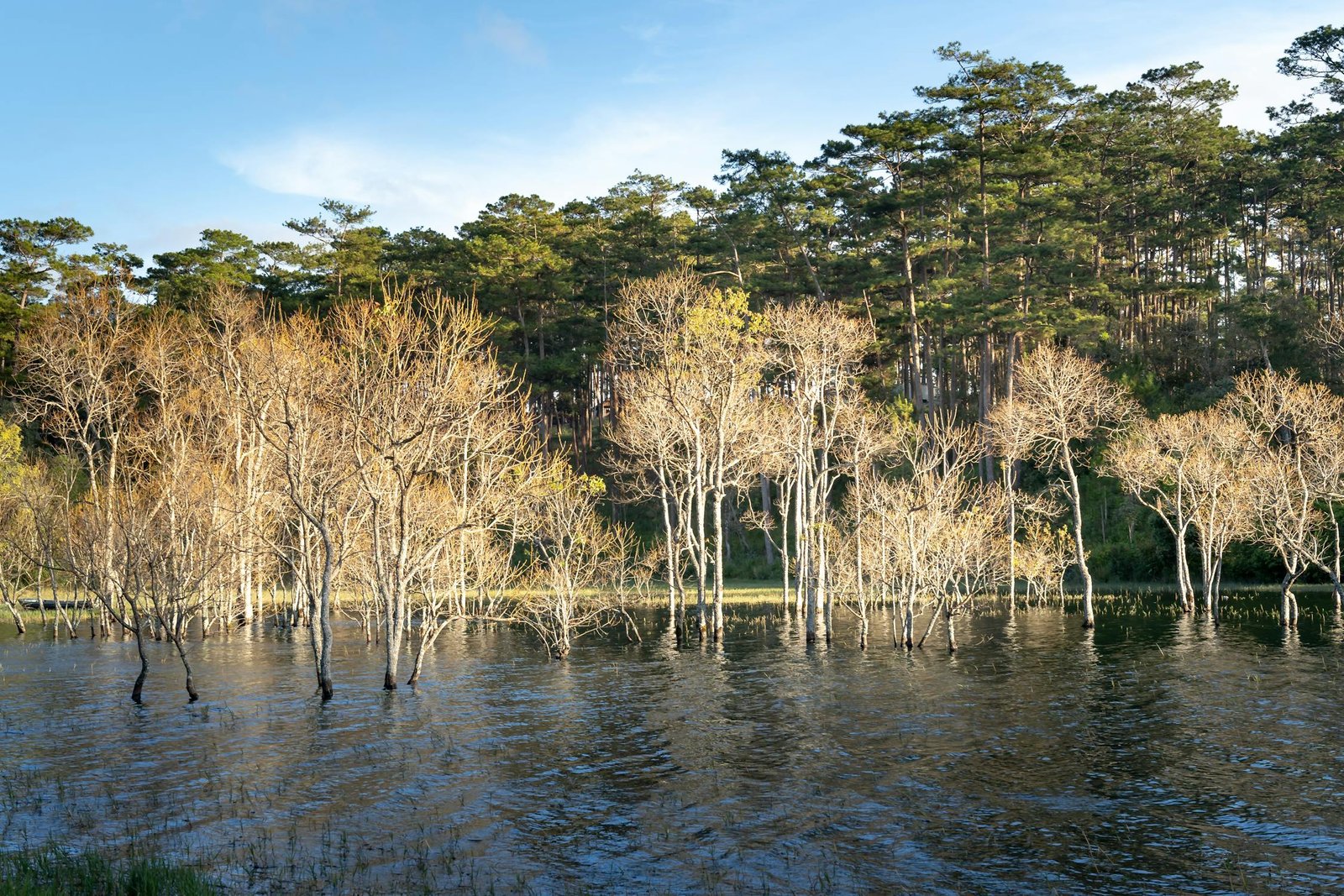
Albedo & global warming. Changes to land albedo (reflectivity) can also have a major impact on global warming. Dams which cover bright areas of land with dark water, which tends to absorb the sun’s heat rather than reflecting it back into space, can significantly contribute to the warming of the earths surface.
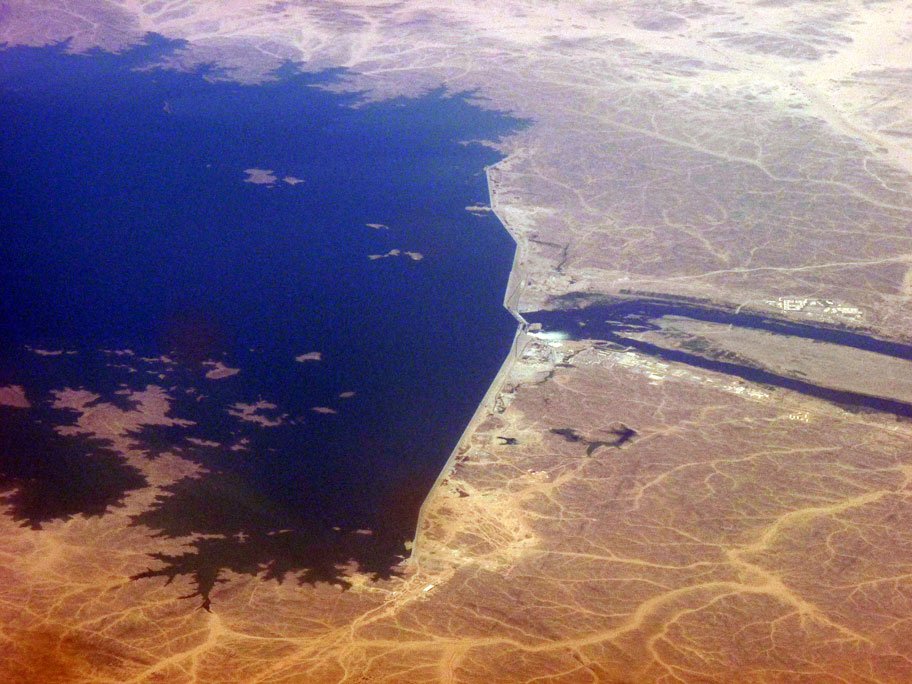
Habitat destruction. And we cannot forget about habitat destruction – forests, grasslands, marshes, deserts, and mountain habitats are flooded to become aquatic. Wild rivers become tame and tepid. Natural sediment movements are retarded or entirely stopped. Fish & aquatic life migration is stopped, and habitat altered or destroyed. And while the land & water areas still remains ‘natural’, it is a fact that they have been radically re-shaped by the action of man.
Habitat fragmentation. Migrating aquatic animals can suffer as well, especially fish that may be cut off from their spawning habitats. A damned river can effectively turn into two separate habitats, an upper habitat totally cut off from the ocean, sea or lake that the river empties into, and a lower habitat cut off from the upper reaches of the river. Solutions like fish ladders, which allow fish & eels to bypass the dam, are a widely utilized solution.
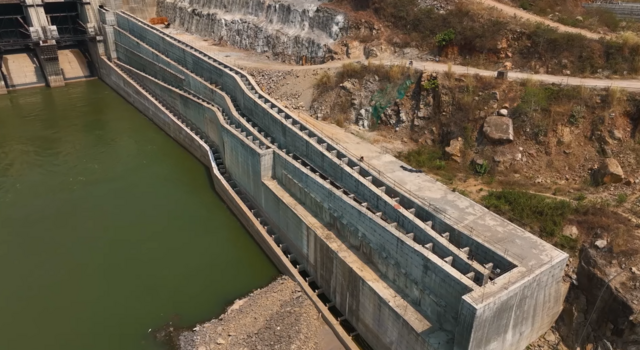
Dry season unreliability. When the dry season hits and the rains stop, hydro energy output can plummet – sometimes entire plants are shut down as the hydro lakes dry up, leading to power restrictions, scheduled & unscheduled blackouts, energy price spikes and the need to purchase (potentially dirty) power from Costa Rica’s neighbors. In 2023, the El Niño cycle was super intense, leading to scant rainfall and severe drops in hydro lake levels. The following year, the national utility ICE (Costa Rican Electricity Institute) had to resort to rolling blackouts in order to conserve energy as hydro power output plummeted. Only unexpected rainfall in early May, associated with the emerging La Niña, saved the day. A similar critical power shortage event occurred in 2007 and also led to unexpected blackouts.
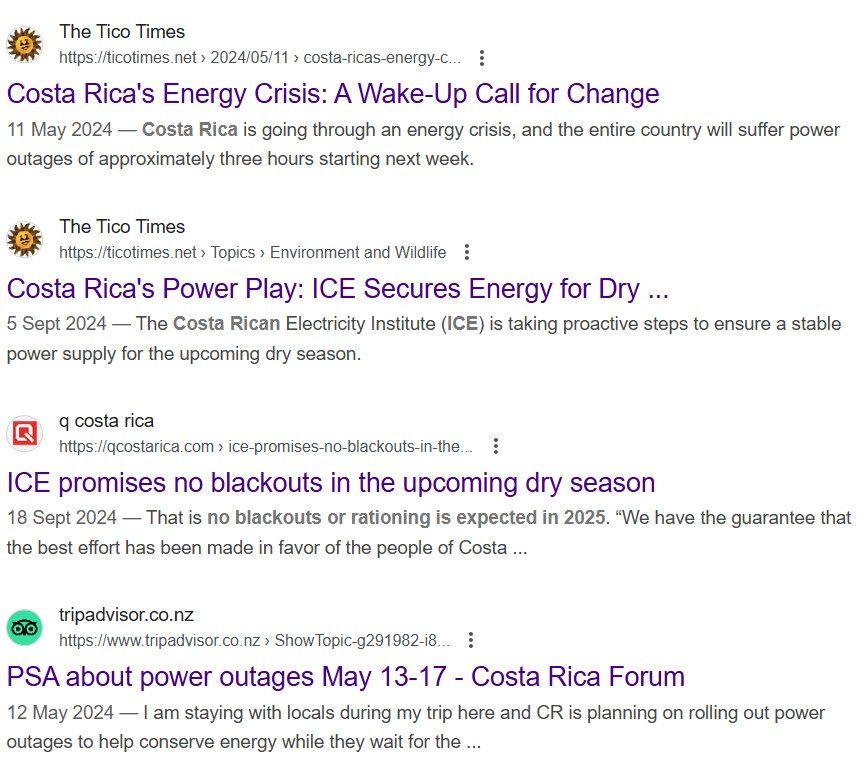
Flooding and relocations. Lastly, local residents may need to relocate and entire town or even cities may need to be moved. And in many parts of the world, indigenous inhabitants are forced to flee their ancestorial lands. The contentious Diquis Hydro Project in Costa Rica is a great example of these issues ultimately stopping a new hydro development.
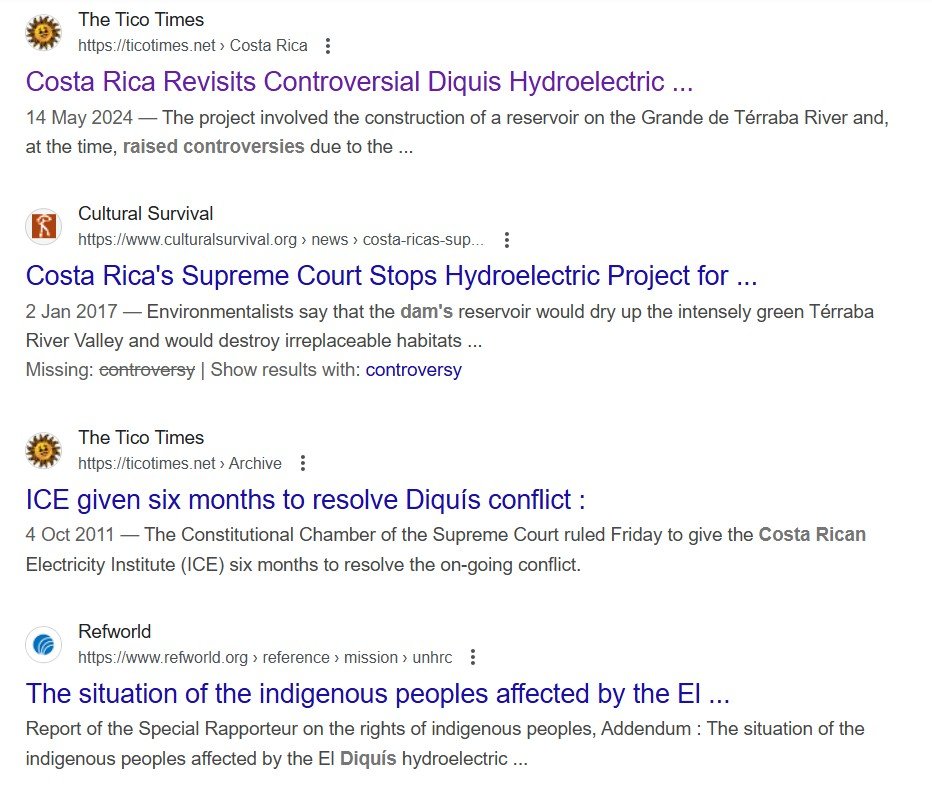
Many of the above drawbacks do not apply to the so-called ‘run of the river’ hydro projects, where the energy of a river is harnessed without the construction of a reservoir. Costa Rica does have a number of such plants to compliment the reservoir/storage type projects.
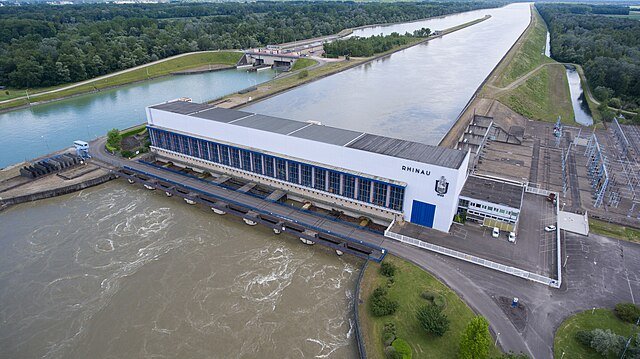
WIND POWER – 17%
Of Costa Rica’s 18 wind farms, 16 stand in Guanacaste Province, also the location of the country’s first wind energy project —Tierras Morenas—launched in 1996. The location offered an average wind speed of 11m/s and the ability to produce power 90% of the time – awesome conditions! In the graphic below, red & purple areas represent average wind speeds of over 10m/s, the perfect condition for wind farm deployment – Guanacaste and Alajuela provinces are especially windy and this is why you find all of Costa Rica’s wind farms in those areas.
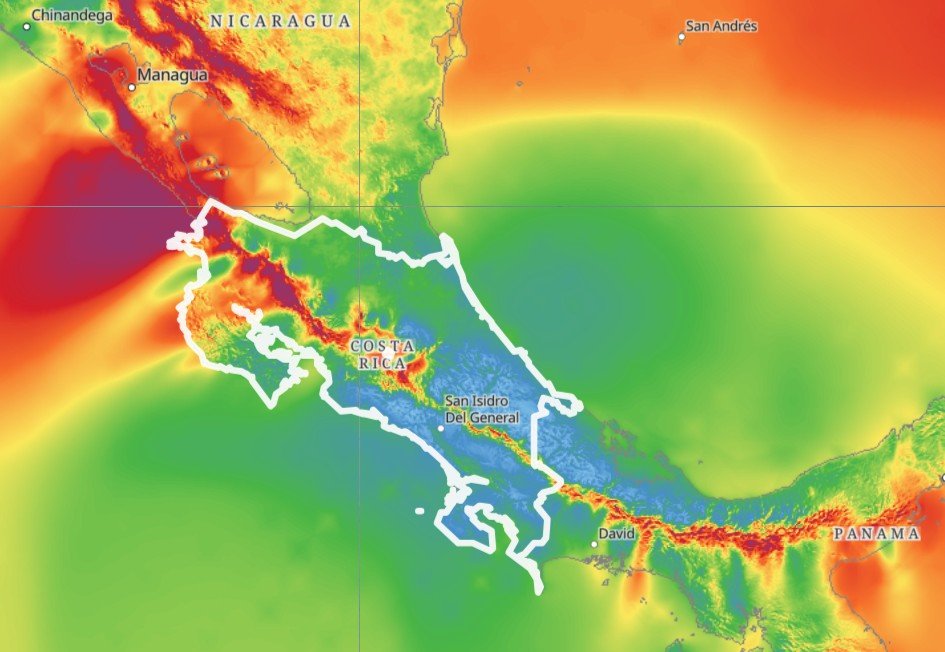
About 17% of the nation’s power is generated by capturing the energy of the trade winds that dominate our weather, and wind power plays a crucial role when it comes to generating dry-season electricity.
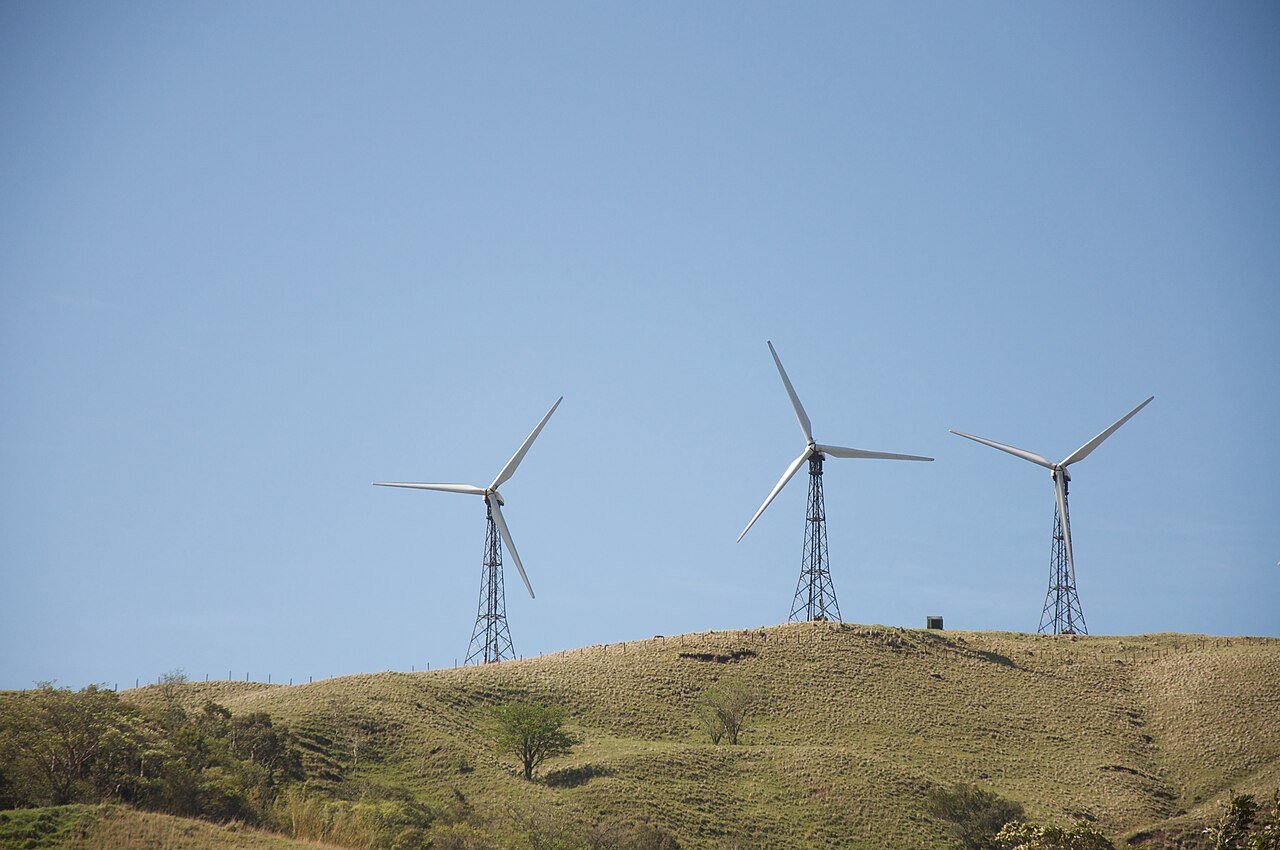
THE GOOD – WIND POWER:
Backup during dry season. As we saw above, hydro power provides the bulk of Costa Rica’s electricity, but its Achilles’ Heel – the dry season – can drastically cut production. This is where wind power shines – picking up the slack to fill in the gap. While December to April see hydro power production plummet, during this time, the northeast trade winds sweep across the country especially in northern regions like Guanacaste – creating consistently strong wind conditions that are perfect for energy generation. Wind power for the win!
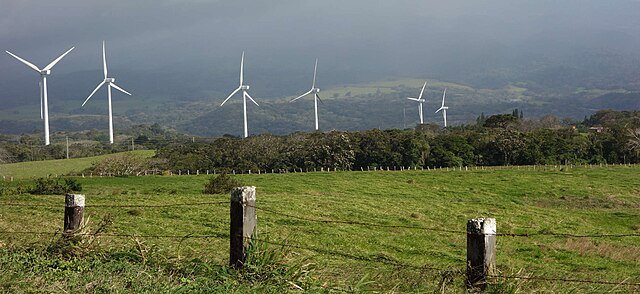
Tiny footprint. Wind turbines take up a relatively small portion of ‘real estate’, ensuring that soil is minimally disturbed and even allowing for farming and ranching activities to continue around the structures. Compare this to hydro power which can drastically alter huge areas of wilderness, turning sprawling forests into underwater graveyards, deep river valleys into serene bays and productive farmland into useless underwater deserts.
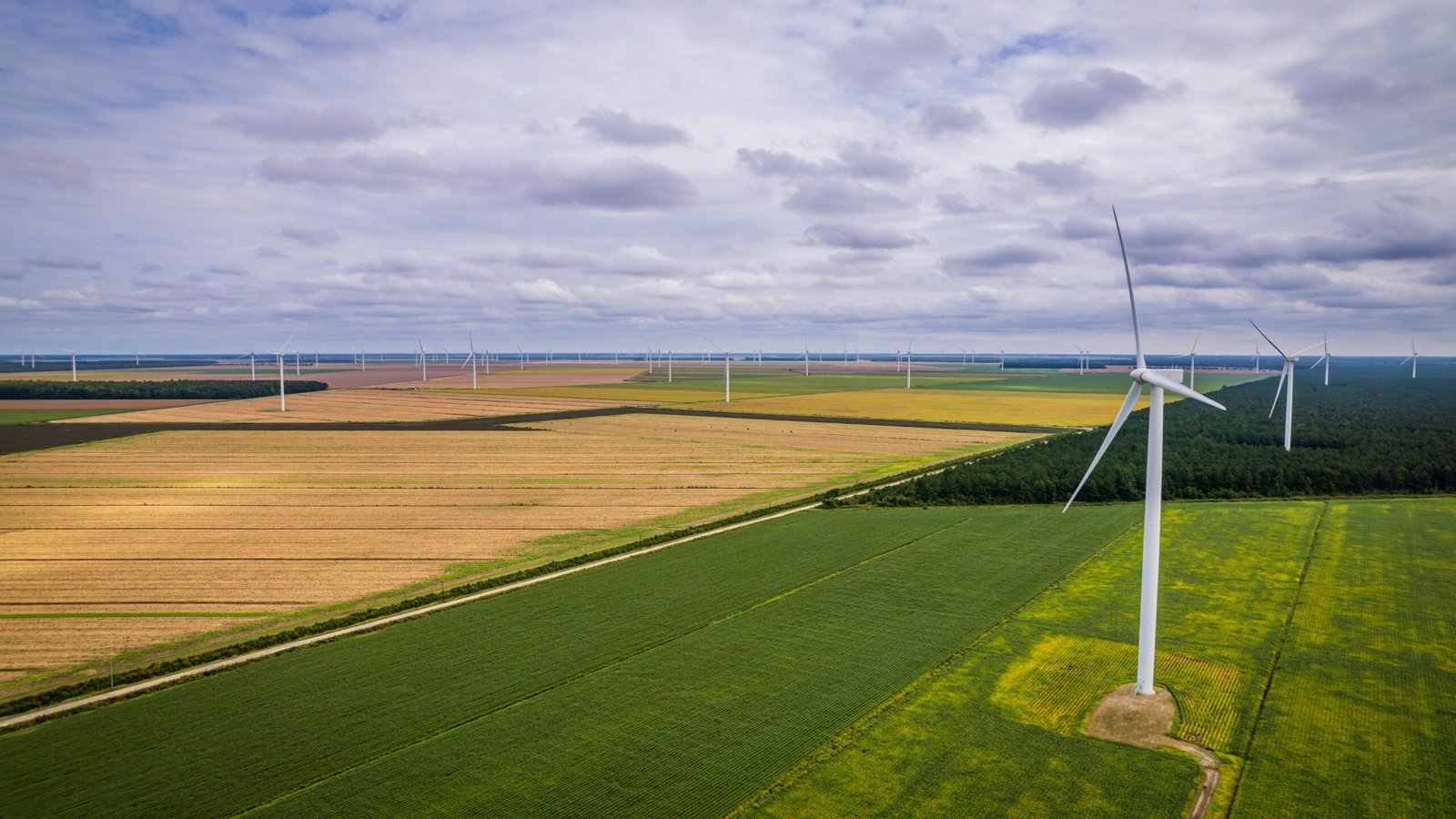
Fully Renewable. Wind energy is fully renewable – large movements of air are stripped of a miniscule fraction of their energy even by the most sprawling of wind farms. Like elevated water that moves our hydro generators, wind energy is ultimately created by the sun – as unequal heating of our planet creates horizontal pressure differences that try to equal each other via wind.
Low cost. And wind energy is cheap – globally, onshore wind is the cheapest energy soruce. Values may vary be country, region, and year, but the general trend is very clear.

Low CO2 release. As is the case with hydro power, the act of power generation is very low when it comes to the generation of greenhouse gasses. The flow of air is the only energy which is converted to electricity.
THE UGLY – WIND POWER:
Blight. While some people find wind turbines to be nice additions to wild landscapes, other view them as industrial blight. Seeing dozens or hundreds of turbines spread across pastoral vistas or extending for miles across mountain ridges can stir up resentment, and in many cases – rightfully so. Overhead high-voltage lines, themselves a blight on landscapes, are often erected to carry the green power away, sometimes to power cities hundreds of miles away. Ageless landscapes with long histories can become transformed into modern powerplants. This debate is ongoing.
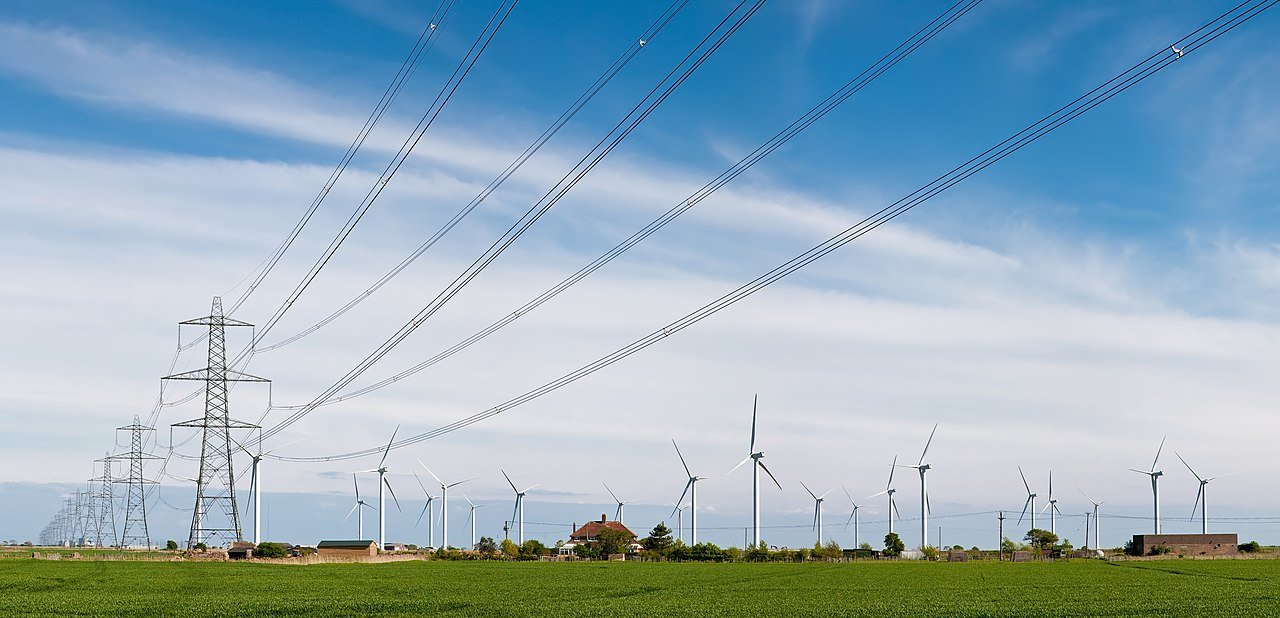
Health effects. Many people who live near wind turbines (especially within 2km) report negative health effects. Turbine blades cutting through the sun can create flickering shadows that many people link to headaches, migraines, and even epileptic episodes. Low frequency noise and high frequency swishing can disrupt sleep and lower quality of life. People living near the towers have also reported effects like difficulty concentrating, tinnitus, dizziness, ADHD, stress, mood changes, and other conditions. These purported effects have been unofficially termed “Wind Turbine Syndrome” or WTS. Current studies are ongoing and there are mixed results as to the veracity of these claims and of WTS itself.

Bird deaths. Photos and videos of birds encountering the spinning turbine blades, and the horrible aftermath, have made their rounds. Famously, President Trump stated “If you want to see a bird graveyard, go under a windmill someday. You’ll see more dead birds than you’ve ever seen in your life.”
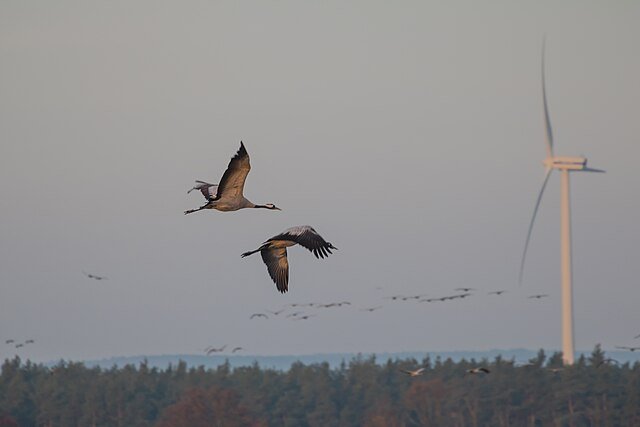
That wind turbine blades present a lethal danger to birds is clear and evidenced. But the scale of the problem seems to be greatly exaggerated. US data suggests that, annually, fewer then 1 million birds meet their end at the tips of wind turbine blades – compare this to an estimated 1 billion birds that perish from flying into windows (1000x the deaths) or 4 billion that are dispatched by domestic & wild cats (4000x the deaths). Other studies find that the scale of wind turbine bird deaths is an order of magnitude lower. So while, proportionately, wind turbines are responsible for a miniscule fraction of human-caused bird deaths, the scale of the issue seems much much greater due to the air time it is getting, and the shocking videos that are circulating social media.
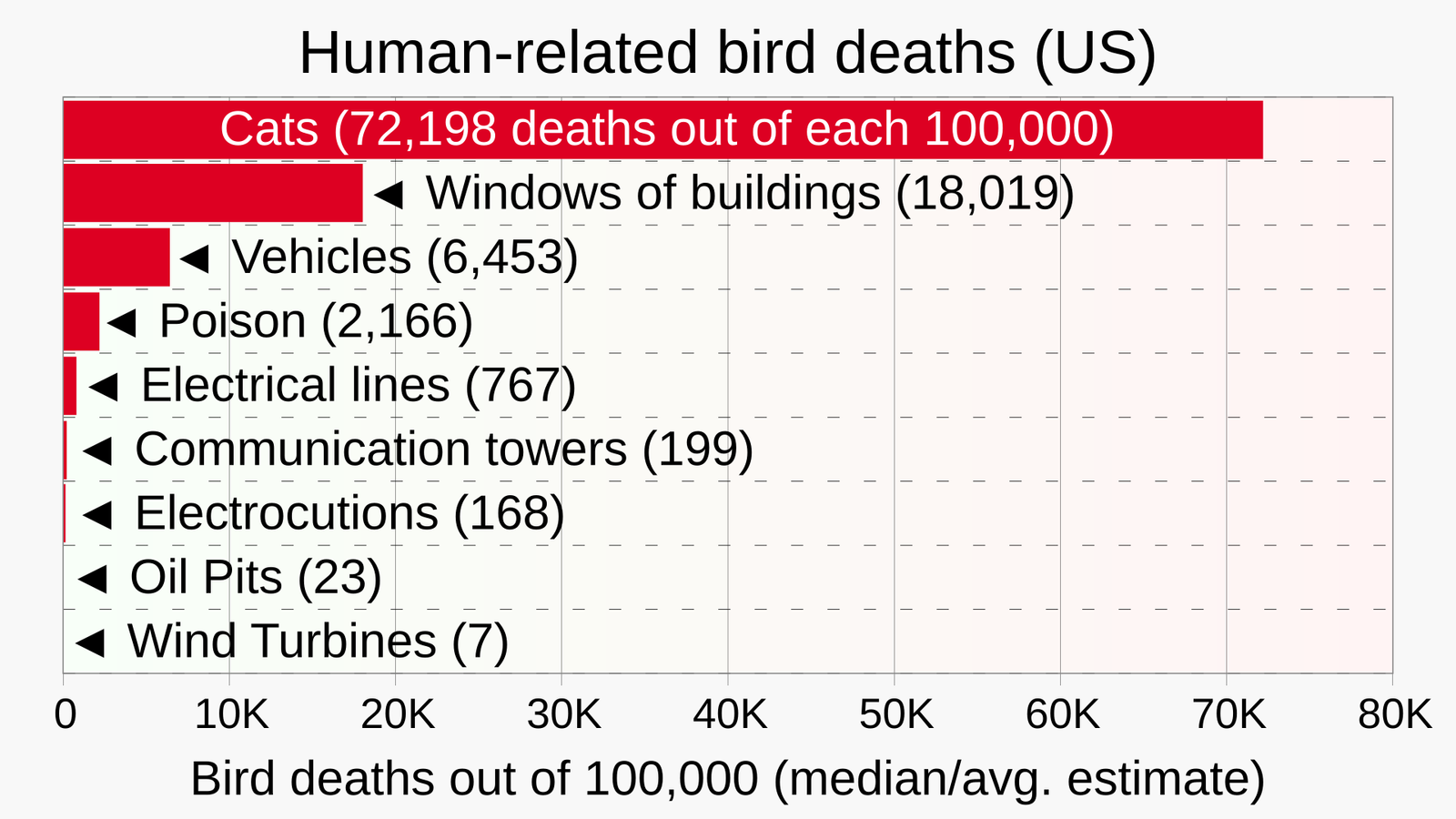
Poor recycling options. As is the case with bird deaths, the claims that wind turbines need to be buried after their retirement is bigly exaggerated. Wind turbines are primarily made of recyclable materials like steel, copper, and aluminum. The large blades, however, are often made of fiberglass or carbon fiber composites and are more challenging to recycle. Current practices involve recycling 85-95% of the turbine’s total mass, with blade recycling still under development. However, there are innovative solutions emerging for blade recycling, including mechanical processes, chemical recycling, and repurposing for other applications. But the shocking pictures remain to cloud the opinions of the uninformed:
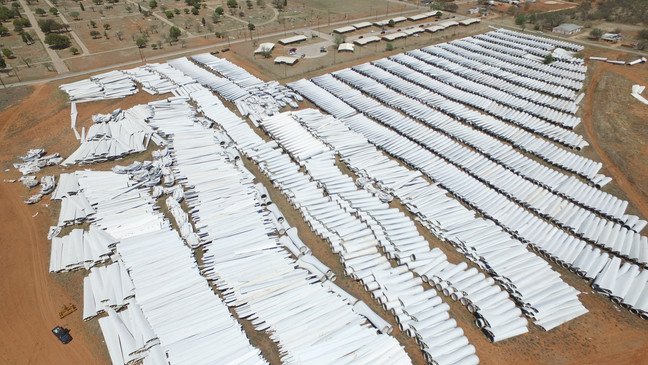
All this oil! A typical wind turbine holds about 300 liters of oil which is used to lubricate the moving components of the mechanism inside the housing. This oil needs to be changed every 12-18 months. While the changed oil can be recycled, repurposed, or burned for energy generation, most of the time it is disposed as hazardous waste. And once or twice a year, we are bombarded with dramatic videos of wind turbine fires. In fact, dozens of turbines burn every year – approximately 1 in 2,000 of them go up in smoke annually due to lightning strikes or malfunctions in the electrical or mechanical systems of the turbines. But, all in all, these are small numbers and these events get much more publicity than they deserve.
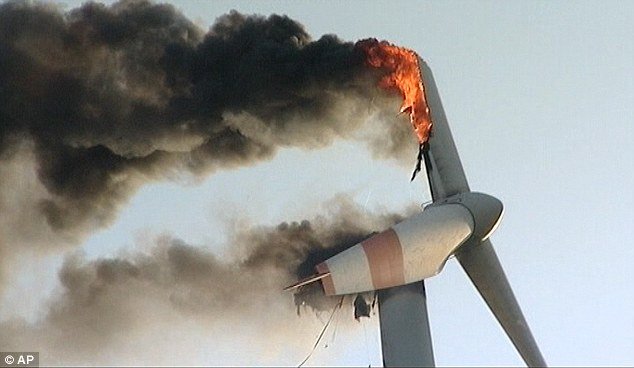
Intermittency. Perhaps one of the most serious wind power issues – when the wind ain’t blowing, the blades ain’t spinning, and ZERO power is produced. In my road and train travels I have seen entire farms with hundreds of wind turbines sitting idle, not even a hint of movement in the blades. This is par for the course and expected – the trouble comes when the calm winds coincide with cloudy weather (low solar energy output) and dry conditions (low hydropower output) on a hot day (high power demand). Many countries that rely heavily on wind power have experienced power crises after days of low wind and high demand due to, for example, people running their AC units during a heat wave. In those cases the countries need to purchase electricity from their neighbors or fire up fossil fuel generation. With advances in battery storage technology and generation diversification, the effects of intermittency will be diminished – but for now, we are still at the mercy of the Wind Gods.
Wind Theft. Sounds made-up, but ‘wind theft’ is an actual term and an emerging issue. While wind does not belong to anyone and cannot be ‘stolen’, the concentrated placement of wind farms in some areas can have a material effect on production efficiency. A large wind farm extracts enough energy from the wind to slightly reduce the wind speed for some kilometers behind the turbines – and in cases of large farms and specific conditions, the effect can extend for up to 100km. While the reduction is slight, the construction of a new wind farm in front of an existing project can devastate the financial efficiency and profitability of the downwind establishment due to the slightly decreased power generation output.
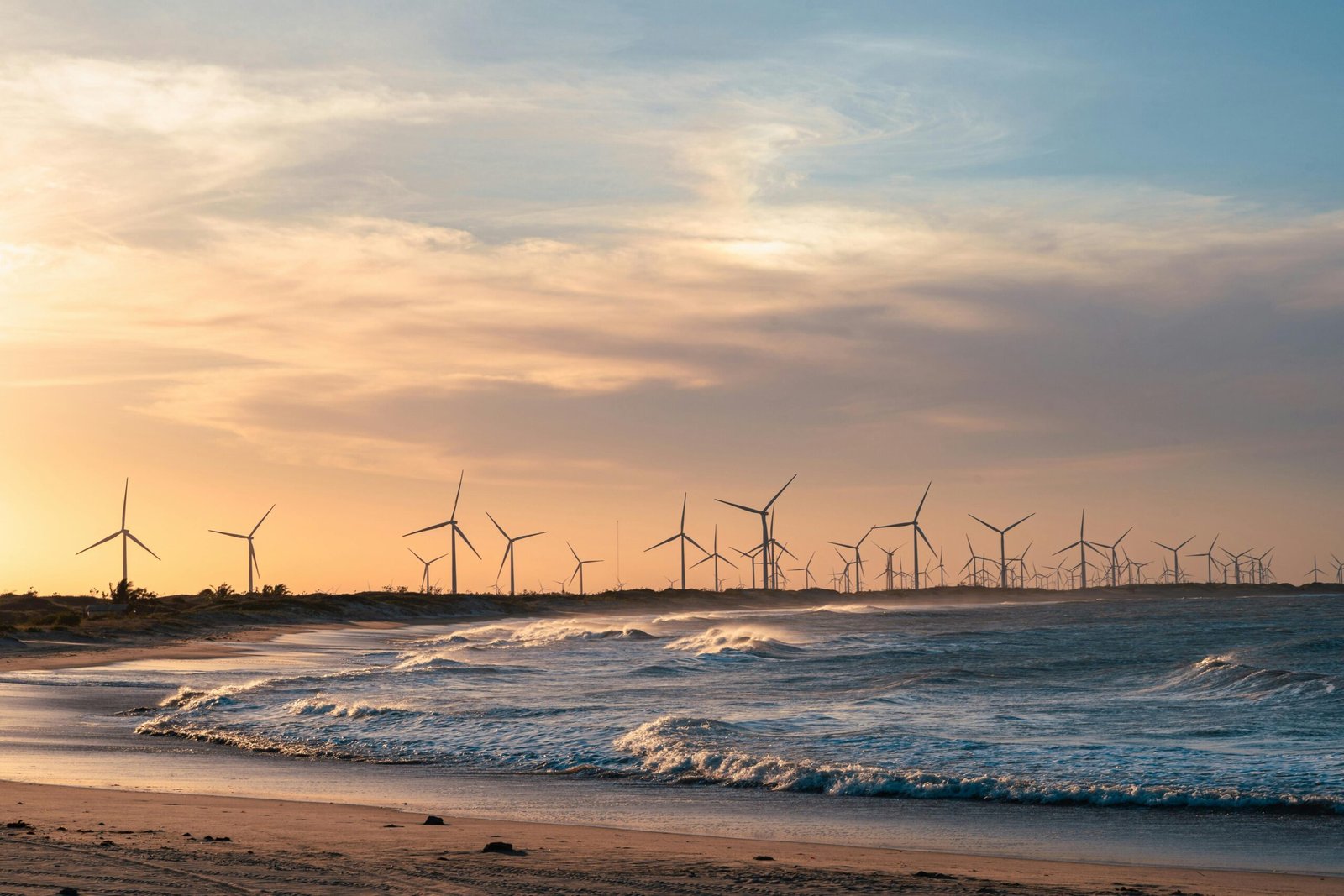
GEOTHERMAL POWER – 14%
Costa Rica, being an actively volcanic country, is rich in potential geothermal power – in fact it can rival wind power for a share of the total energy generation pie. And, as was case with wind & solar power, the province of Guanacaste is leading the way in production. Geothermal power is, perhaps, the ‘greenest’ energy out there – and while not as ‘sexy’ as wind and solar, geothermal plants are using underground steam or superheated water to turn turbines that generate a large chunk of Costa Rica’s electricity.
And these plants can operate even if the groundwater is below boiling temperature – by using a binary cycle system. In this system, the lower-temperature geothermal water heats a secondary working fluid with a much lower boiling point than water, like pentane or butane. This secondary fluid is vaporized, and the resulting vapor then drives a turbine to generate electricity.
Unlike the case with Solar Power, ICE is actively developing additional geothermal capacity with several projects on the books or in development including around Rincón de la Vieja National Park.
THE GOOD – GEOTHERMAL POWER:
Reliability and Consistency. Unlike solar, wind, or hydro power, geothermal energy does not suffer from intermittency issues – the wind can stop blowing, the sun can hide behind clouds, and droughts may dry up hydro lakes – but you can be sure the earth will stay hot in the right places and reliably help to deliver geothermal power. And geothermal plants can keep going for 50 years or more – in some cases the thermal reservoir may cool or its pressure may drop, necessitating output reduction and eventual plant closures – but there is plenty of warning and, more often than not, plants inject water back into the bowels of the earth to replenish the reservoirs and keep the plant operating indefinitely.
Fully Renewable. The amount of heat being held inside our planet is incomprehensible – our current use is not even registering as a rounding error. In addition to primordial heat left over from the formation of our planet, radioactive decay of several element present in the Earth’s crust and mantle continuously produces additional warming. It is estimated that the Earth’s total geothermal energy could power 5,000 civilizations like ours – and while only a fraction of the heat is accessible to us using our *current* technology, the power available to be harnessed TODAY could meet our energy needs THREE times over.
Versatility in Use. The steam or hot water not only turns turbines to generate electricity – it can also be used to directly heat homes and businesses and provide hot water straight from the depths of Earth’s crust. Many geothermal plants also utilize networks of pipes that deliver the heat & hot water to nearby buildings. A great example is a plant in the city of Southampton, UK – it supplies the Port of Southampton with electricity and delivers heat and hot water to over 1,000 residential properties, a few dozen commercial properties and, in all, thousands of Southampton locals.
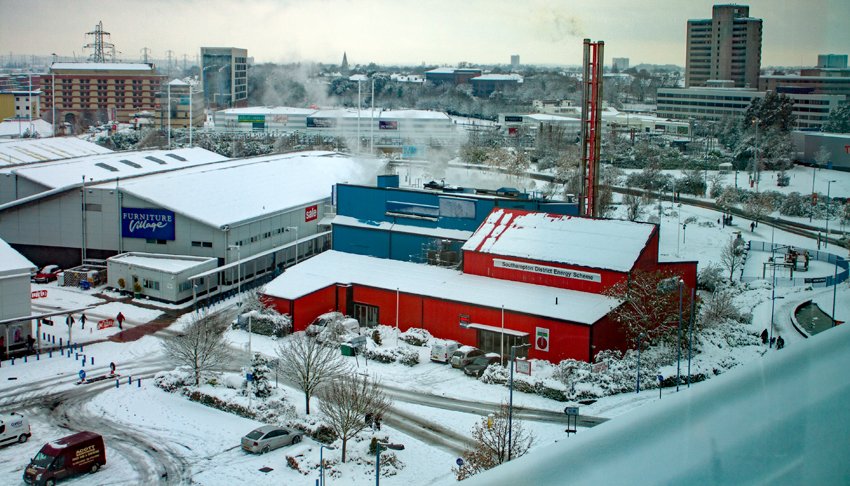
Small Footprint. As seen in the photo above, geothermal powerplants have a very small footprint – they do not stretch across vast areas of countryside like solar panels and do not blight large swaths of natural areas like wind turbines. Even the largest of power plants exist peacefully and hold a kind of a charm – the clouds of steam often seen rising over the structures induce an allure and fascination as we know the billows of white vapors came directly from the active, red-hot guts of our planet. We hold the same kind of emotion when looking into steaming and smoking volcanic craters, bubbling mud pools or boiling hot water springs.
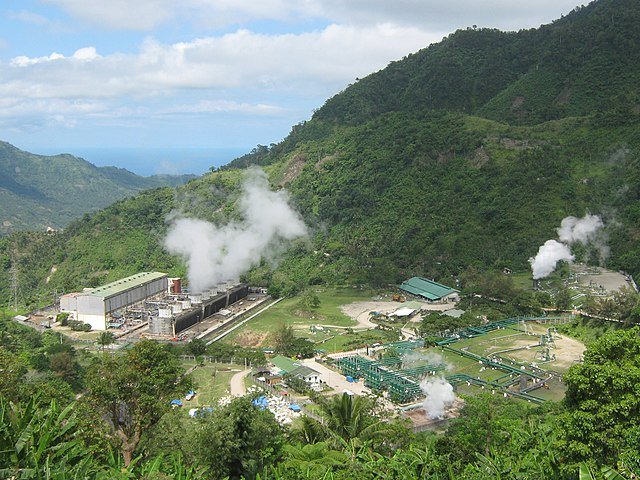
Low production CO2 release. There is very little CO2 released during operations and even construction of geothermal power plants – owing to their compact designs and sole reliance on steam or hot water.
Low cost. Geothermal power plants are typically very cheap to construct and operate – the plants are small and compact, and steam and hot water are consistent, abundant, and long-lasting. They require minimal staff to run the generation and maintenance requirements are low and predictable. The only burdens to their approvals may be the sometimes sizeable costs of exploration – meaning scoping out potential geothermal fields and drilling test wells to ascertain the capacity of the hot water reservoirs. But overall, geothermal power has been shown to provide very cheap electricity.
THE UGLY – GEOTHERMAL POWER:
Location specificity. Geothermal powerplants need to be positioned in very specific locations, preferably on top of existing & shallow underground geothermal reservoirs. Otherwise, piping may need to be constructed to bring the hot water or steam to an off-site geothermal powerplant location. This can add complexities, reduce efficiencies, increase resource use, be unsightly and may not always be possible due to competing land uses.
Potential high upfront costs. While the plants are usually cheap to build (if the well is not too deep) and operate, significant exploration costs can add up to make them unviable or unpopular. Geologists and engineers (expensive) need to study geological formations and direct exploratory drilling (also expensive) that peeks into great depths of hundreds of meters or even kilometers underground. That is why places where hot water is near surface – volcanically active areas – hold the bulk of these plants.
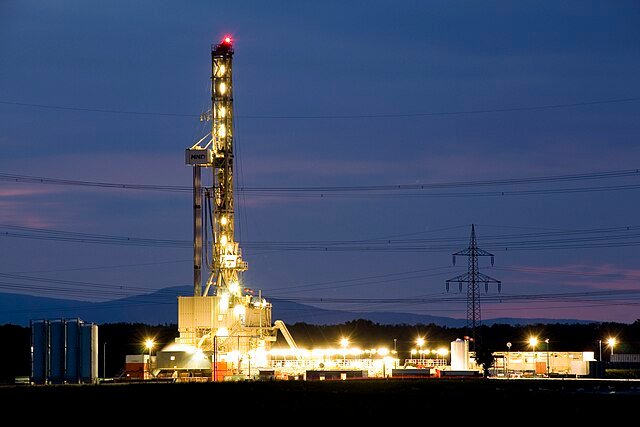
Earthquake generation. Geothermal power plants can affect the underground equilibrium, triggering earthquakes by activating sleeping faults or inducing land subsidence – most often as a result of exploratory drilling, plant construction, hot water extraction or the injection of cold water back into the underground reservoirs.
In 2017, South Korea experienced the 5.2M Pohang Earthquake – which caused $300 million USD in damage, injured 82 people and crippled the city of Heunghae. This was the country’s largest earthquake in modern history – and its cause was directly linked to fluid injection due to geothermal projects in the area.
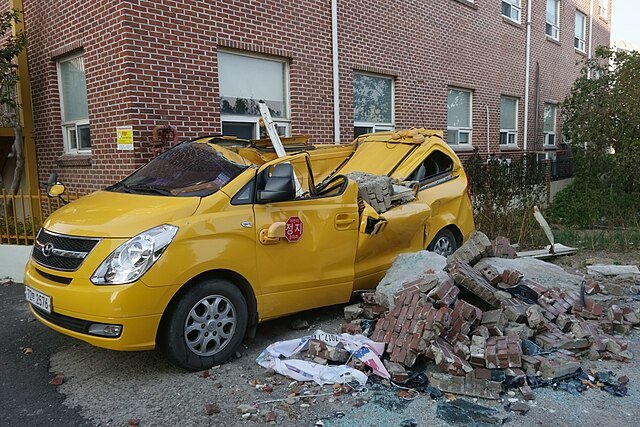
Trace gas emissions. While rare, geothermal plants can release hydrogen sulfide, ammonia, arsenic, methane, carbon dioxide and other gases from deep underground. These gases may be present in the steam or initially dissolved in the hot water, but they separate and vaporize as the water is brought to the surface. In closed loop systems this is not a problem because the water or steam never come in contact with the atmosphere and is returned to the reservoir. But in other cases, the gases are either vented into the air or ‘scrubbed’ using machinery – as is the case with the dangerous Hydrogen Sulfide.
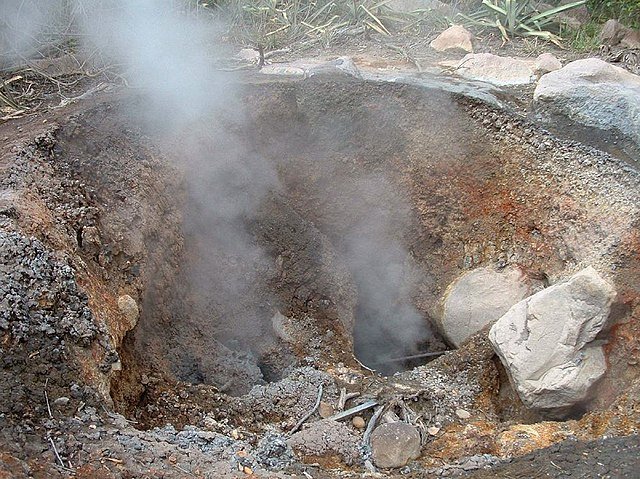
Depletion of reservoir and environmental shifts. Geothermal plants that do not reinject water may affect the groundwater levels in the local areas of operation. This can have an effect on local plants, waterways, lakes and wildlife. In addition, the removal of groundwater can lead to land subsidence. Re-injecting the water back into the reservoir, once cooled, is the main mitigation strategy.
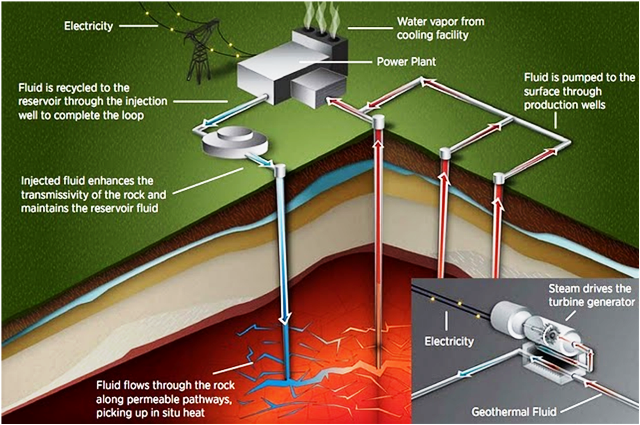
SOLAR POWER – >1%
There is SO MUCH solar power generation potential in Costa Rica – suspiciously in the same area that is also the best place for wind farms and geothermal power generation – Guanacaste province. And yet the nation trails the world in the use of the sun for electricity generation – only about 1% of Costa Rica’s electricity is generated by solar cells. This has been so mainly due to burdensome solar power taxes, the lack of solar generation incentives, and the lack of interest by Costa Rica’s electricity provider ICE.
Which is a shame since solar farms could prosper in the country – prime solar locations exist very close to the major Central Valley population centers like San Jose, Cartago, and Heredia as well as the touristy Nicoya Peninsula where every square inch is prime solar power habitat. But there is hope – CE is now beginning to invest in solar power. A new solar farm in Guanacaste has just been announced and upon completion in 2027 it will be, by far, the largest one in the country. This farm will join several others that are already producing or under consideration or construction – with most, still, being led by the private sector.
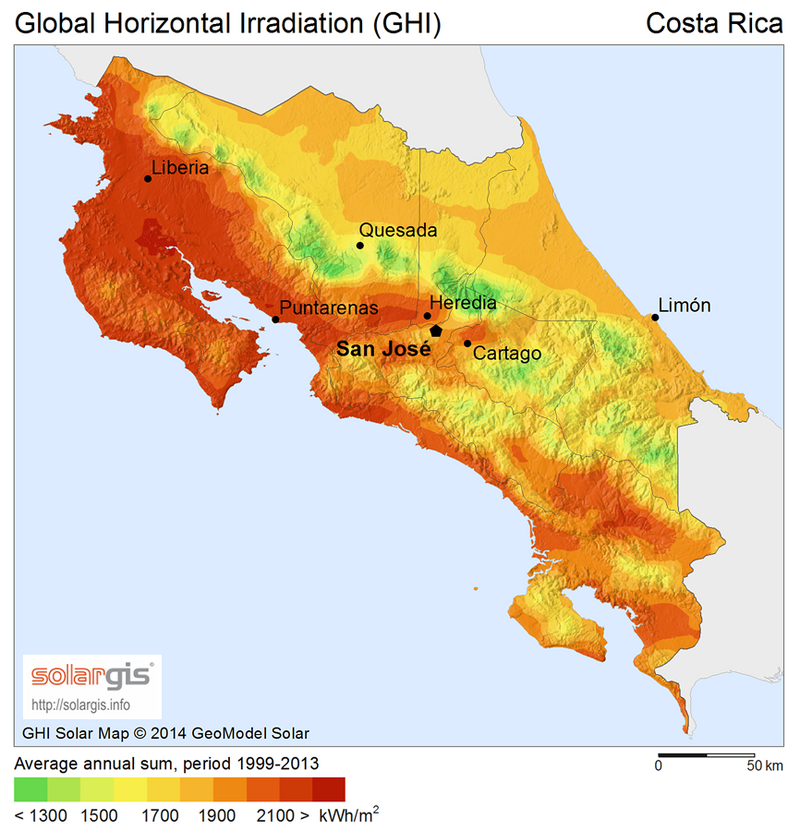
THE GOOD – SOLAR ENERGY:
Scalability. From massive solar farms that cover hundreds of square kilometers of land to tiny rooftop or portable installations, there is so many options for creating the right mix for the conditions and requirements.
Existing land use utilization. While there has been some pushback when it comes to large solar farms, the world’s cities present great opportunities – large installation can cover the roofs of stadiums, shopping centerers, and office buildings. Elevated solar farms can be constructed over large carparks or transport hubs like airports or train stations – so not only will the panels produce electricity very close to the demand locations, they will also shield the public from the hot sun or the soaking rains. A win-win.
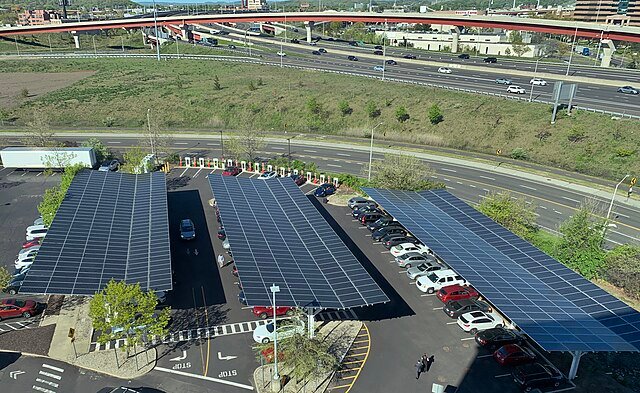
Silent and unobstructive. Unlike the conspicuous and loud windmills, solar farms are much better at blending into the landscape. While some people still consider them to be a blight upon rural or wild areas, the small and even mid-sized farms have a way of following the contours of the land. And once they are installed, they stand low and silent.
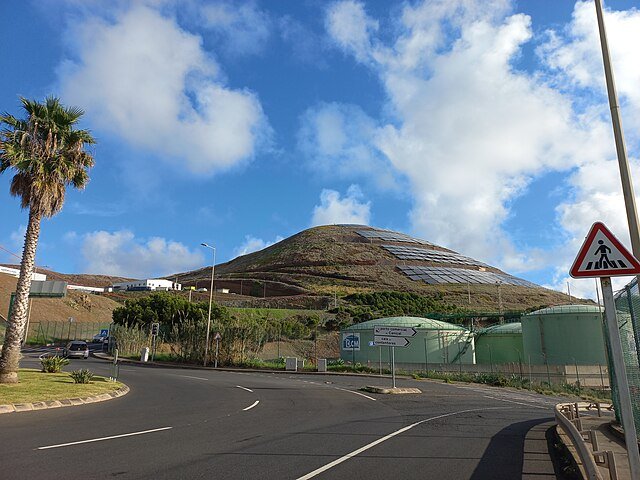
Low cost of operation. Like geothermal plants, solar power plants are cheap to operate – but can be expensive to build. And while there are additional maintenance and upkeep costs, this is still one of the cheapest forms of energy.
Low production CO2 release. Very little CO2 is released during the operation of solar plants – however the carbon footprint of solar power is material and mostly associated with manufacturing, transport, commissioning and end-of-life activities. It is estimated that it takes 1 to 4 years for a solar plant to ‘pay back’ its carbon emissions.
THE UGLY – SOLAR POWER:
Toxic chemical. Cadmium Telluride, Silicon Tetrachloride, Hexafluoroethane, Arsenic, Lead – all of these toxic & highly toxic chemicals compose solar panels or are used in the manufacturing process. And while dangerous substances are held securely within the solar cell components, problems arise when damage allows them to leak out into the environment – this happens due to hailstorms & earthquakes, accidental damage, corrosion & decomposition, and during decommissioning and disposal. In additions, workers who manufacture the panels can be exposed to deadly chemicals – the majority of solar panels are made in China with most of the reminder being constructed in Vietnam, Malaysia and India – places where H&S laws are not as strict as in the west. As the technology evolves, solar panels are becoming less and less reliant on the toxic chemical stew – but still have a long way to go.
Poor recycling record. Globally, only about 10% of spent solar panels undergo recycling. With about 85% of their components like glass, aluminum, copper, and plastic being ripe for recycling, problems arise due to the solid construction of the panels. Made to last 20-30 years, solar panels are constructed with performance, cost and reliability in mind – recyclability does not enter the picture in any material way. These complexities make solar panel recycling a money-losing enterprise and these costs can add up to the total life costs of solar panels – in addition to the unaccounted environmental damage caused by simply tossing the panels into landfills, a fate that awaits 90% of all solar panels. It costs $20 to recycle a typical panel, and recovered materials add up to about $10.
Blight. Earlier we talked about how solar farms can spring up over carparks and shopping centers, filling urban land and providing much needed shade and rain protection. But there is another side to solar farms – big industrial-sized projects that cover up to hundreds of square kilometers of wilderness or productive farmland. Unlike wind turbines that gracefully coexist with farms and ranches, most solar farms take over the land in totality – often bringing with them high voltage power lines to carry away the electricity.
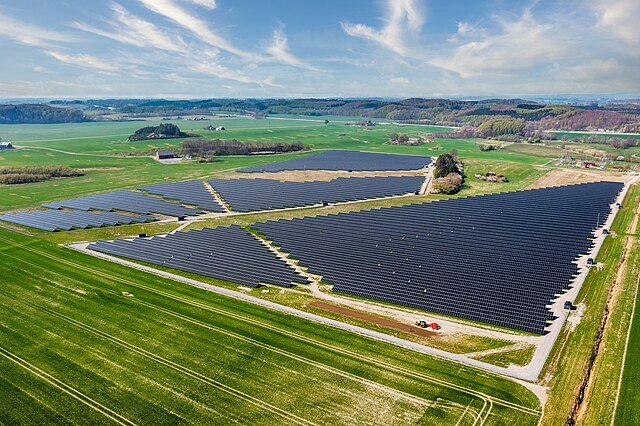
There are options to address this issue being – for example, vertically mounted two sided panels can co-exist with productive farmlands. Bifacial (two sided) solar panels capture light from both sides and can use reflected light to generate electricity, so their efficiency is higher than one-sided panels. Tradeoffs involve more expensive upfront costs and the need for very specific conditions to exist in places where bifacial farms are envisioned.
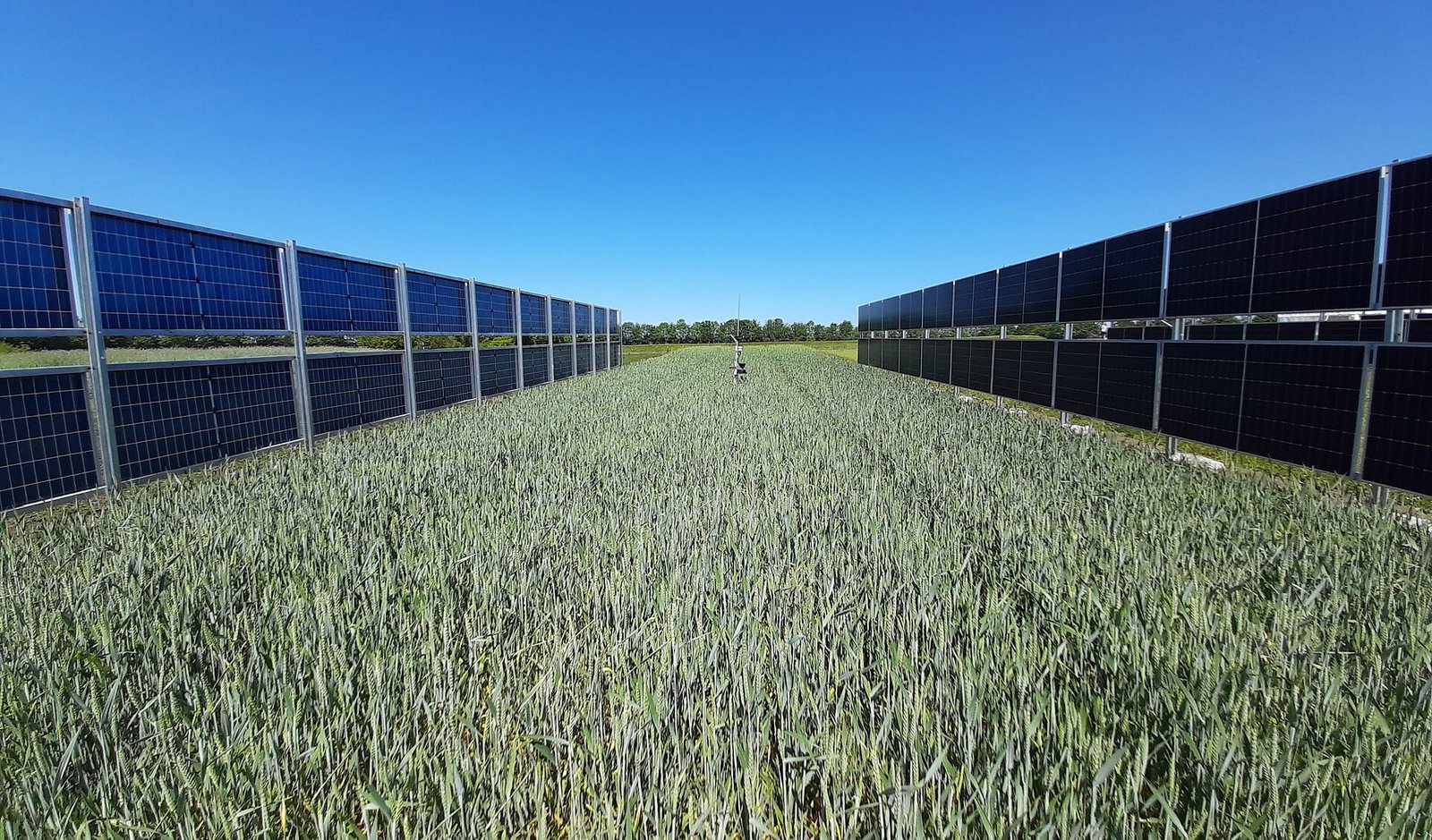
Dirt & Grime. Solar panels can lose a significant percentage of their generating capability due to foreign matter build-up. Dust, grime, ash, snow, condensation, bird dropping, insects, leaves & branches, salt spray – no matter where the solar panel is located, it is likely to be affected by one issue or another.
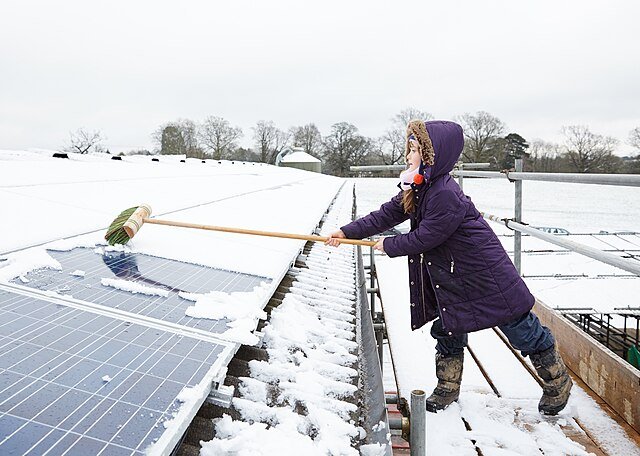
Cleaning the panels can be expensive, ongoing, labor-intensive and can damage the units. In the future, the task will be performed by machines but for now it is left up to humans.
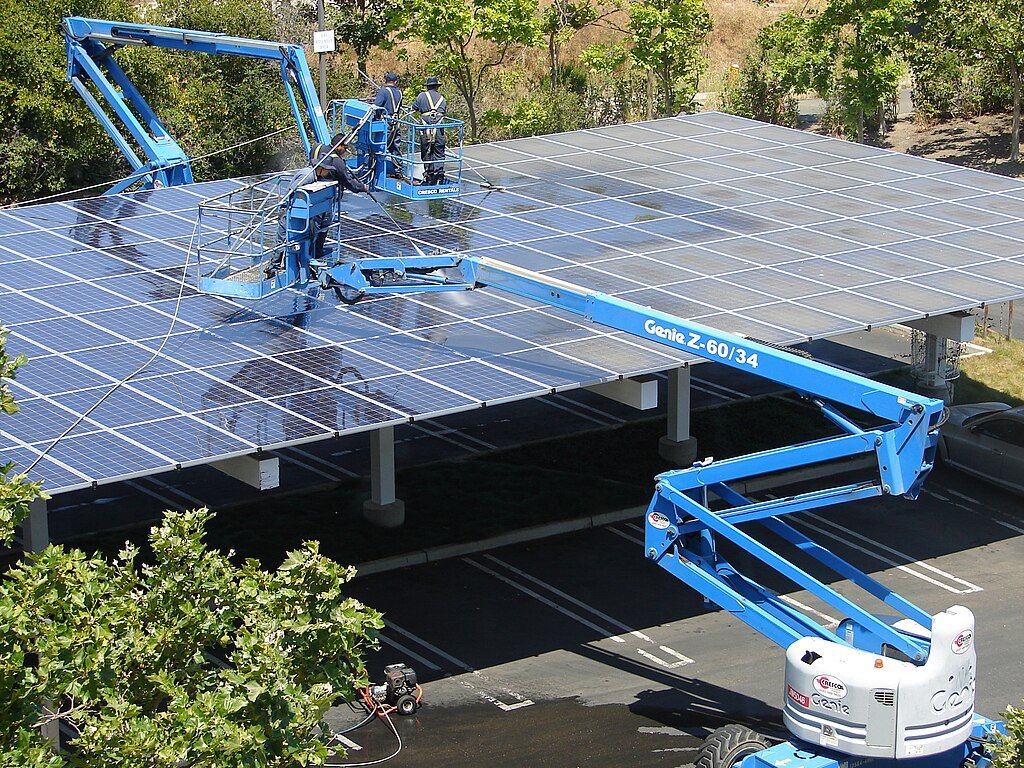
Hail. Solar power’s nemesis. Hailstorms can put entire solar farms out of business, destroying the majority of panels and potentially contaminating the land with toxic chemicals that may leak out. There are mitigations such as expandable nets that can be extended cover solar panels when a thunderstorm approaches, stowage systems which turn the panel to a more vertical position in order to minimize the surface area and angle of impact, or the manufacture of strong panels rated to withstand hail. Of course there is a significant cost element added to these strategies – often it is better to take a chance and HOPE a hailstorm will not pass over a solar farm, and this seems to be the most popular option.
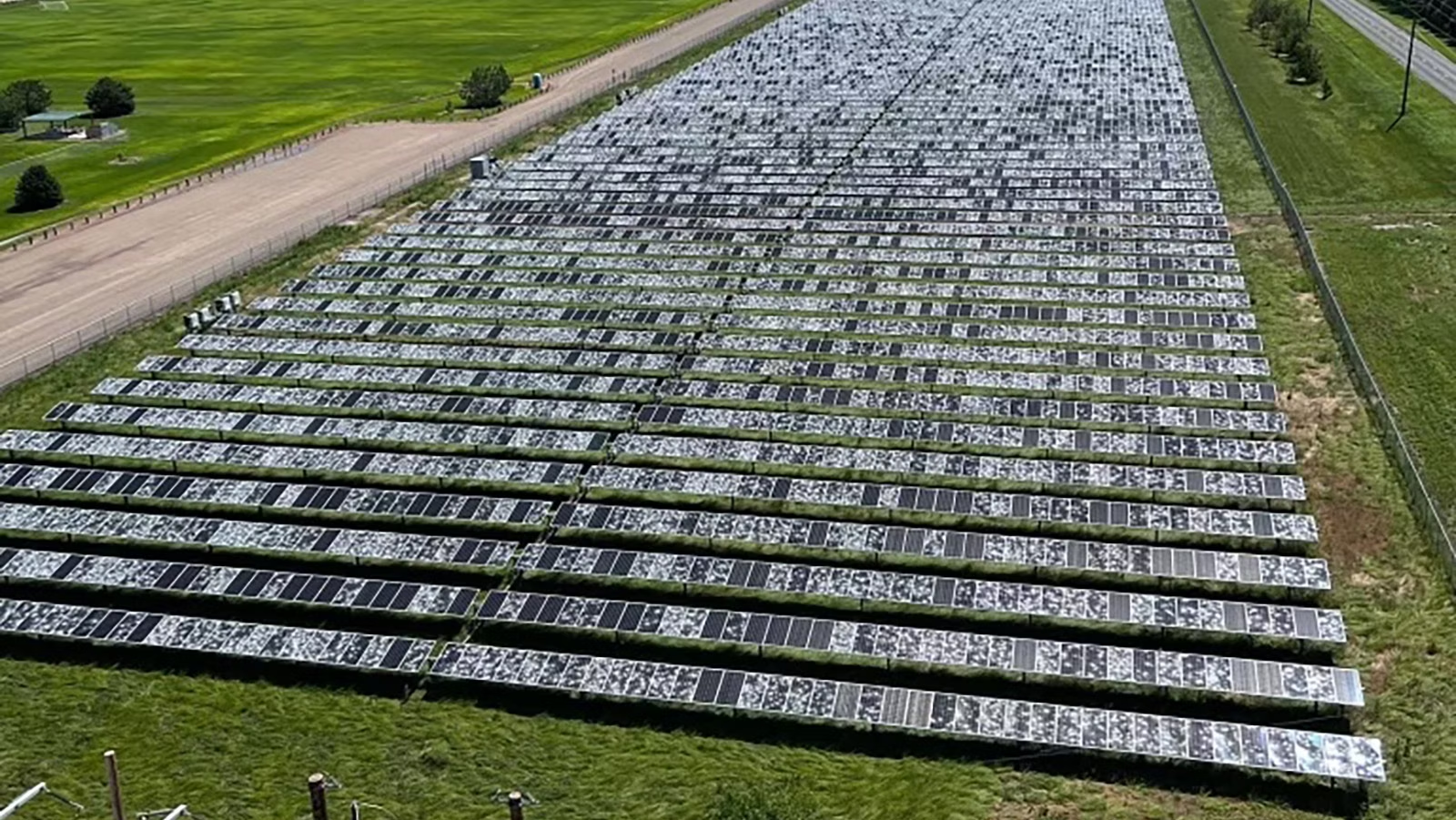
BIOMASS POWER – >1%
This is a up-and-coming segment of Costa Rica’s green energy mix. Biomass power is derived form burning organic waste. Costa Rica is investing in biomass power as a part of their green energy mix and, already, biomass is being used to produce steam in many industrial & agricultural plants
THE GOOD – BIOMASS POWER:
Burning biomass is carbon neutral. Contrary to common sense which says that ‘burning’ anything is not good for the environment, in this case the process is actually carbon neutral and a part of the natural short term carbon cycle. Yes, the burned waste will release greenhouse gases – but the waste would also release the same greenhouse gases through the process of natural decomposition. And the plants which grow in the place of the waste will re-absorb the same amount of carbon from the atmosphere, essentially completing a closed-loop cycle.
Landfill diversion. Not only does the burning of biowaste to generate electricity keep the product away from filling up the landfill, it also prevents the biowaste from releasing a much more potent greenhouse gas – methane. Methane, a greenhouse gas 86 x more potent than carbon dioxide, is released when organic matter decomposes without the use of oxygen – such as when it is buried in a landfill or, as we talked about in the case of hydropower, when it is flooded. Burning the waste releases carbon dioxide, completing the closed loop short term carbon cycle mentioned earlier. A double win!
Availability. With set logistics, biomass power stations can run 24/7 and do not face intermittency pitfalls of solar, wind and hydro power.
THE UGLY – BIOMASS POWER:
NIMBY. Many people oppose biomass power stations being built in their backyards – while it is considered to be ‘green’ energy, it still involves the burning of organic matter and potential release of particulate matter and toxic or foul smalling emissions. This can be mitigated by constructing the plants in more sparsely settled areas and utilizing emission filtering & scrubbing.
Fuel Management. While ideally what is burned is true biowaste, it has been a practice that areas of pristine forest are cut down for biofuel without being re-planted – turning the exercise into a net carbon emitter & biodiversity destroyer. Corruption & misleading information are often involved even in western countries. For example, biomass burned in the UK in the form of wood pellets is shipped across the Atlantic, sourced from American forests – with accusations that important ecosystems were felled. Does this sound green? Sustainable forestry can support a net-zero biomass industry, but often areas of pristine forests are felled and replaced by monocrop tree farms. And crops grown specifically for biomass powerplants use resources in the form of water, fossil fuels, and chemical fertilizers, pesticides & herbicides. Not green at all and definitely not carbon neutral!
Land vs Fuel. If the fuel is not true waste but grown specifically for power generation, biomass crops may compete with food crops – this has an effect of increasing the price of important food staples.
Transport. Biomass fuel has low energy density – and thus constant, round-the-clock deliveries of fuel add csosts, complexities and greenhouse gas emissions.
Cost. Biomass plants are expensive to build and operate – they need round-the-clock activity to keep them going as they are considered to be ‘base power’ assets and thus must operate 24/7 with a constant output. In addition, due to the low energy density of the fuel, transport costs really add up. Biomass energy is amongst the most expensive electricity generation methods – sometimes surpassing coal, oil and gas generation costs.
Greenhouse Gas Emissions. Due to the constant need for duel delivery, biomass plants emit considerably more Carbon Dioxide than the other green generation methods – and this is not counting the release of combustion gasses which, as mentioned earlier, are a part of a closed loop carbon cycle (IF true waste is burned). With time, as the transport sector itself becomes green, this should become more in tune with the other green sources of power. Smaller operations, for example those in Costa Rica where local waste is burned on site to generate steam for industrial processes, are more or less excluded from this problem – but as larger-scale projects are being planned and built, we are not out of the woods just yet.
Costa Rica is already considered to be one of the most biodiverse countries in the world, celebrated for her wildlife, commitment to conservation, and an all-out reversal of deforestation that is a model around the world. Add to that our record of green electricity production and it becomes evident why this land is celebrated for its commitment to sustainability. We invite you to browse the local properties available in our area, knowing that RE/MAX WE SELL PARADISE is your trusted partner in the South Pacific corner of Costa Rica.


